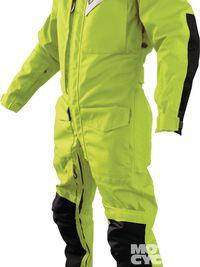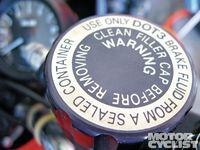Got A Question For Answers? Send It To mcmail@sorc.com
Invisible, Man
I've been riding my trusty Honda 919 to work and leaving my Ford F150 in the garage since the price of unleaded cracked $4 per gallon. Averaging 42 mpg is great, but sometimes it feels like I'm invisible out there. What should I be doing and/or wearing to help the average dim-bulb driver actually see me?
Derek Laufer
Corpus Cristi, TX
_For starters, wear white or brightly colored gear. Motorcycle Safety Foundation Vice President Rob Gladden says feeling invisible is a good thing if it reminds you to ride like you’re invisible. Never assume the driver of another vehicle sees you. Beyond that, wearing black is a bad idea. “According to a study from New Zealand, wearing a white helmet was associated with a 24 percent reduction in risk. Keeping your headlight on and aimed correctly is very important as well. There’s been some discussion about high-beam vs. low-beam because the high-beam can obscure your front turn signals. A headlight modulator can increase your conspicuity if using one is legal where you live.” _
_Where you are on the road is important as well. “Think about your lane position,” Gladden says. “Don’t hang out in someone else’s blind spot. If you’re riding alongside another vehicle, don’t ride at their four o’clock or their eight o’clock. Make sure you’re in their line of sight. Put yourself in the driver’s seat of the cars around you and think about what you can do to make yourself more visible.” _
_Play what Gladden calls the What-If Game, as in, What if that dilapidated ’68 Olds Toronado cuts across my bow? “It keeps you scanning the riding environment, always keeping an exit route, or two, or three. It also keeps you actively engaged in riding. It’s easy to start thinking about what’s for dinner or what you’re going to do when you get home while you’re humming down the freeway. Playing What-If keeps your head in the game.” _
If you haven’t been riding regularly, Gladden says the MSF’s online Rider Perception Challenge (www.msf-usa.org/riderperception) can help you learn to recognize virtual danger sitting in front of your computer, making it easier to avoid real trouble on an actual motorcycle.
FAQ
Magic CAN-Bus
What exactly is a CAN-bus system? I know it has something to do with getting electricity from one part of the motorcycle to another, but how does this arrangement differ from the wiring harnesses we all know and love?
It’s basically a digital answer to the same old analog question. Once upon a time, the wires, diodes, switches and such of that loveable wiring harness were all you needed to power and control a relatively humble list of electrical chores. Managing a modern motorcycle’s explosion of onboard computers requires something considerably more sophisticated.
_Enter the CAN-bus system. Developed for all manner of industrial applications and perfected by Bosch nearly 30 years ago, it orchestrates all your digital acronyms—anti-lock brakes, traction control, engine management and the like—along with all the other electrics, without running miles of wire all over the chassis. _
Using what’s called a Controller Area Network protocol—the CAN—and a differential cable arrangement—a.k.a. the bus—such systems let a bike’s various computers talk to one another and share information quickly and efficiently. Built-in diagnostics make it easier to troubleshoot as well. On top of that, improvements or options that might have required a whole new wiring harness in the past plug right in. That cranky old wiring harness doesn’t seem quite so loveable now, does it?
**Tighten Your Belt **
When I bought my BMW F800ST, I thought I had found a sport-tourer with a clean, low-maintenance belt final-drive. Soon afterward my local BMW dealer lost the franchise, and the nearest dealer was suddenly 200-plus miles away. Now I maintain the bike myself using the CD shop manual; however, measuring belt tension requires a special tool whose function I can't duplicate. I tightened the belt once while cold, but when the final drive reached operating temperature, the belt seemed too tight, so I backed it off. I am fairly satisfied with the current setting, but would prefer some definitive means for getting the correct tension. With all the belt-drive bikes out there, is there a general rule for setting belt tension?
Tom Eaton
Tallahassee, FL
According to BMW, the short answer is there’s no quick and dirty way to tell if your belt tension is right because there’s a very fine line between too tight and not tight enough. Hence the special tension tester (part number 83 30 0 417 779) designed to make sure it’s just right. The tester isn’t offered directly to civilians, but an understanding dealer should be willing to sell you one for around $300. Your digital shop manual should tell you it’s time to check and/or adjust said belt every 6000 miles. After 24,000 miles, it’s time for a new one.
One Bike For (Almost) Everything?
Is there one motorcycle out there that can almost do it all? I want something that I can take on a 3000-mile ride in moderate comfort, do 500-mile days, ride back and forth to work 40 miles round trip, and take the fireroad that looks interesting. I am not looking for the perfect bike, but I don't want to have to buy three motorcycles and all that goes with them. I currently ride an '07 Harley-Davidson Super Glide with 90,000 miles and an '02 Suzuki DR650 with 5500 miles. There are so many niche bikes, but there seems to be nothing that can do it all—or at least most of it.
D. Grump
The Arizona Desert
No single bike does it all, but that almost makes it easier. Start looking at adventure bikes; hopefully something with at least two cylinders that add up to 650cc or more. BMW’s R1200GS is the consensus all-surface choice for those who can swing the price of admission. Even clean used examples aren’t cheap. There are less expensive omnivores further down the food chain: Triumph’s new Tiger 800 triple, BMW’s F800GS and Suzuki’s V-Strom 650 twins, and the second-generation Kawasaki KLR650 if one lung seems like enough. Have fun, shop around and we’ll see you out there!
Fluid Intelligence
In the process of liberating my old Yamaha RD250 from the garage after a long, cold winter, I changed the engine and gearbox oil. What about the brake fluid? It looks fine. I haven't changed it for maybe three years, but the bike has been sitting for at least half that time. Should I change the fluid anyway? And at the risk of asking another stupid question, what is brake fluid?
**Ken Blansett
Houston, FL **
Last things first: Brake fluid is a glycol-based concoction designed to transfer force applied at the lever to your caliper(s) and brake pads without compressing in the process. It has to maintain those characteristics from freezing cold to broiling hot. That’s the tricky part. The bad news, even for a bike that’s been sitting, is that glycol-based fluid like the DOT 3 your manual recommends is hydroscopic. That means it absorbs water over time, making it boil prematurely. Your brakes don’t work so well when that happens. Crashing is expensive. Brake fluid is cheap. Just to be on the safe side, flush out the old stuff and replace it with fresh DOT 4 or DOT 5.1 fluid (not DOT 5!) from a sealed container. Do it again every year or two, and keep a close eye on those old lines and seals. Replace anything that leaks and you’ll be fine.















/cloudfront-us-east-1.images.arcpublishing.com/octane/FZXHNOQRNVA3BIDWAF46TSX6I4.jpg)
/cloudfront-us-east-1.images.arcpublishing.com/octane/JRSFLB2645FVNOQAZCKC5LNJY4.jpg)
/cloudfront-us-east-1.images.arcpublishing.com/octane/ITNLTIU5QZARHO733XP4EBTNVE.jpg)
/cloudfront-us-east-1.images.arcpublishing.com/octane/VZZXJQ6U3FESFPZCBVXKFSUG4A.jpg)
/cloudfront-us-east-1.images.arcpublishing.com/octane/QCZEPHQAMRHZPLHTDJBIJVWL3M.jpg)
/cloudfront-us-east-1.images.arcpublishing.com/octane/HXOUJXQWA5HBHGRO3EMJIGFMVI.jpg)

/cloudfront-us-east-1.images.arcpublishing.com/octane/3TIWWRV4JBBOLDVGRYECVVTA7Y.jpg)
/cloudfront-us-east-1.images.arcpublishing.com/octane/KIX5O23D5NAIBGFXBN3327DKZU.jpg)
/cloudfront-us-east-1.images.arcpublishing.com/octane/7GJYDUIPXRGMTMQKN6ONYOLBOU.jpg)
/cloudfront-us-east-1.images.arcpublishing.com/octane/MUQLOVLL2ZDGFH25ILABNBXKTI.jpg)
/cloudfront-us-east-1.images.arcpublishing.com/octane/TNOU5DNE2BC57MFPMGN2EIDXAM.jpg)
/cloudfront-us-east-1.images.arcpublishing.com/octane/GTCXACQGJ5HAPDTGWUQKDEH44E.jpg)
/cloudfront-us-east-1.images.arcpublishing.com/octane/S35YGSEMEZB4BLTDJTSZPF4GLA.jpg)
/cloudfront-us-east-1.images.arcpublishing.com/octane/5UOT6HPX2JFMRJAX6EH45AR4MQ.jpg)
/cloudfront-us-east-1.images.arcpublishing.com/octane/OKWOJWAKP5EP3OACCRRWPCIX2Q.jpg)
/cloudfront-us-east-1.images.arcpublishing.com/octane/2WF3SCE3NFBQXLDNJM7KMXA45E.jpg)
/cloudfront-us-east-1.images.arcpublishing.com/octane/G4MG6OUCJNBSHIS2MVVOTPX65E.jpg)
/cloudfront-us-east-1.images.arcpublishing.com/octane/IIGGWFOTOJGB7DB6DGBXCCMTDY.jpg)
/cloudfront-us-east-1.images.arcpublishing.com/octane/QSTCM6AVEZA5JJBUXNIQ3DSOF4.jpg)
/cloudfront-us-east-1.images.arcpublishing.com/octane/U4I7G625B5DMLF2DVIJDFZVV6M.jpg)
/cloudfront-us-east-1.images.arcpublishing.com/octane/B6XD6LS6IVCQPIU6HXDJSM3FHY.jpg)
/cloudfront-us-east-1.images.arcpublishing.com/octane/ICL63FEDDRDTTMINYICCEYGMDA.jpg)
/cloudfront-us-east-1.images.arcpublishing.com/octane/FCGZHQXRBZFLBAPC5SDIQLVF4I.jpg)